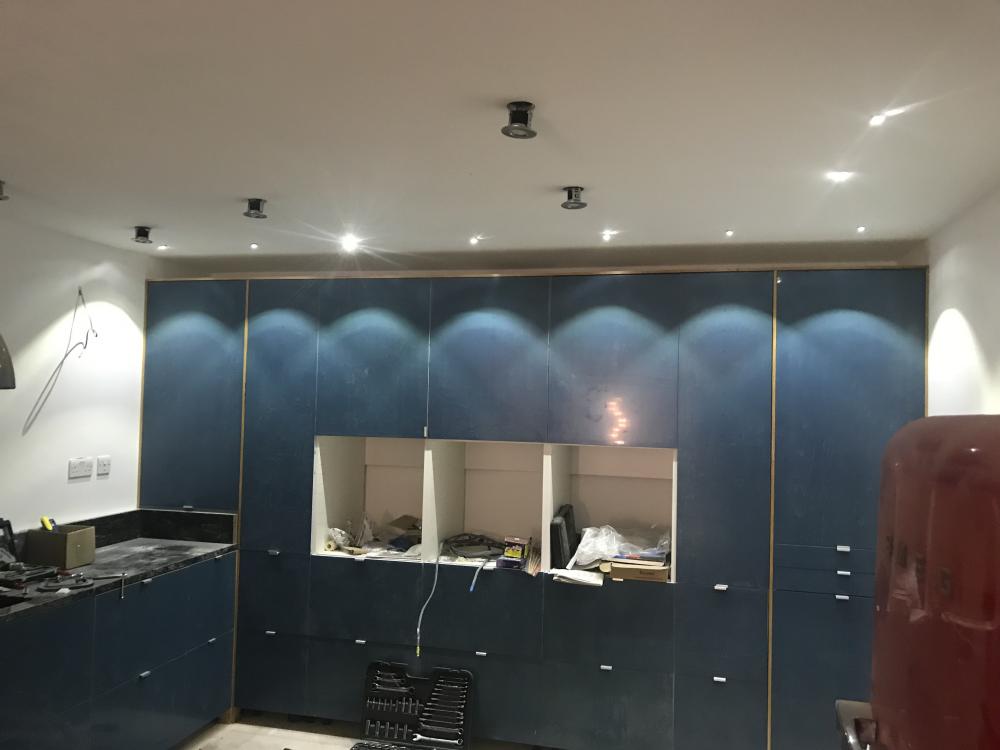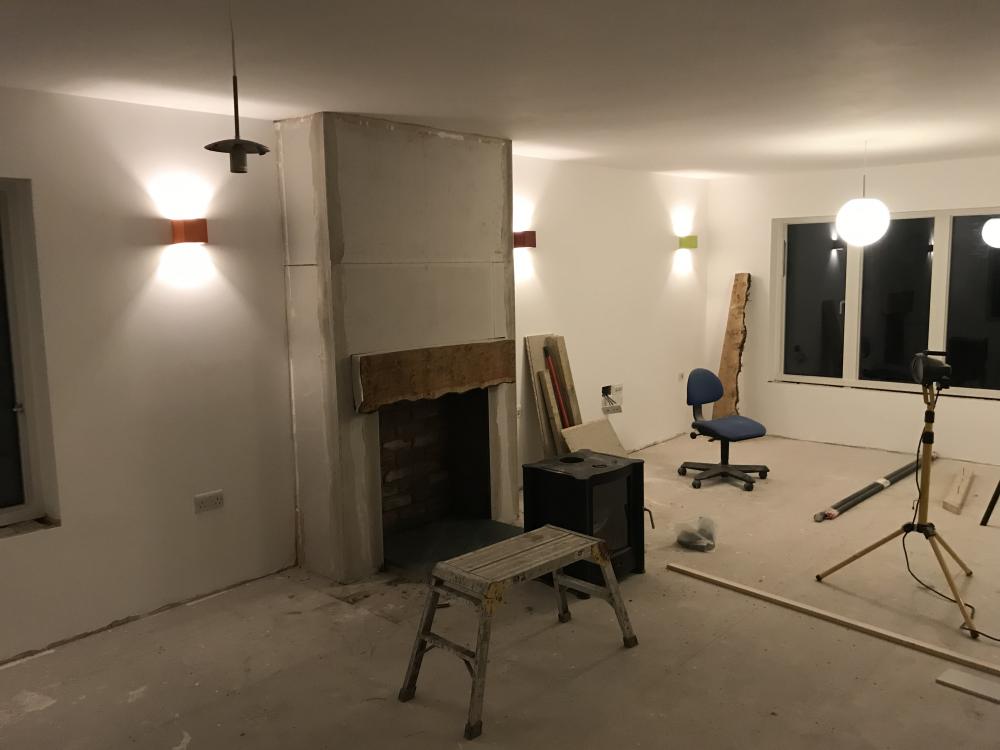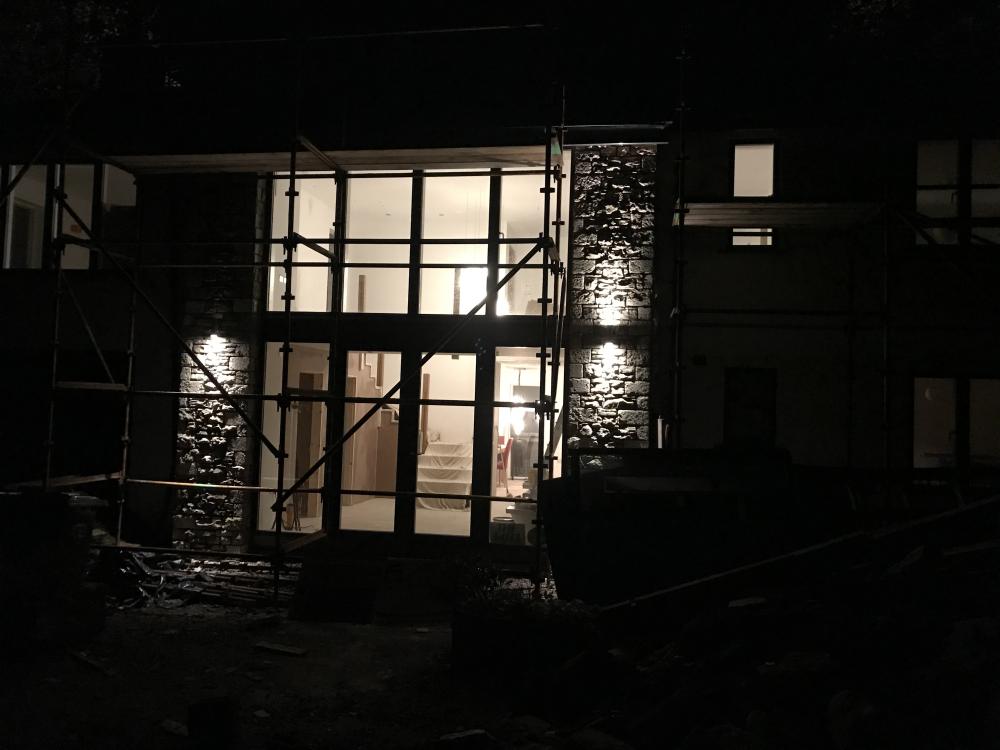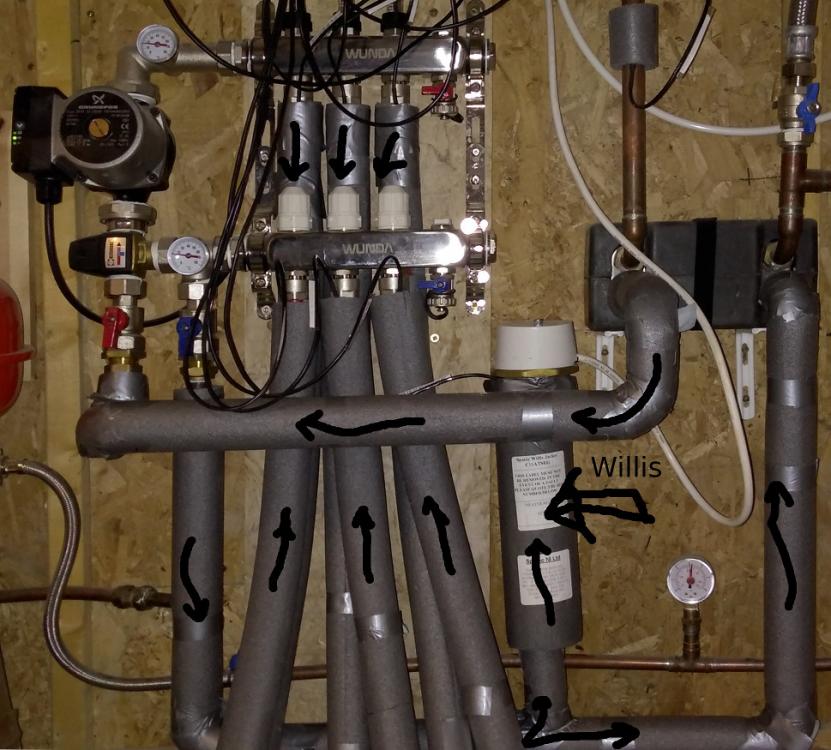Leaderboard
Popular Content
Showing content with the highest reputation on 11/09/17 in all areas
-
6 points
-
For me, FF is everything before the cavity is closed with PB. Broadly agree with the services priority above but rather than taking a strict linear approach, after doing some preliminary planning for each set of services, we got the electrician and plumber (boss) on site at the same time and did a walk around of the site identifying any places where there would be a contest for space (I represented MVHR ) and we agreed alternative routes for a few things to make life easier all round. Because of steels, etc, we had a few 'highways' where lots of services needed to run but it got figured out in the end. MVHR can take up a lot of space if you have a high concentration of ducts coming together and the required bend radius can be a challenge - a poorly placed soil pipe can really bugger your plans. What you want to avoid is giving one trade carte blanche to do what they want and leaving the follow-on trades to figure out how they can live with what has gone before. Of course, if you have a detailed mechanical plan for all services prepared at the drawing stage then you can ensure that your construction has been designed to remove as many conflicts as possible - however these can be expensive to prepare so not everyone does it (and not every trade follows it) - plus you may change your mind about some things as the true internal shape of the house comes together - I know that our ensuite bathroom layout was constantly evolving until first fix commenced. Other things to consider - Data & AV requirements - cat 6 cabling for entertainment, media and old fashioned networking (computers, printers, wifi repeaters etc..). Don't rely on wifi to connect everything - if something is unlikely to move (TV, printer, workstation, STB, xbox etc..) and it supports wired ethernet then put a hard wired connection in - especially if its a high bandwith and delay intolerant service (like video). - Ducts for HDMI cables - we have a TV and media cupboard with trunking in the wall between them to avoid cables on the wall - speaker cables for surround sound (consider new innovations such as Atmos, 7.1 etc..) - Telephony (super old school but handy to have) Socket location for occasional or seasonal use like hoovering / ironing / xmas tree lights) etc. Guarantee is that however many 13a sockets you make provision for, there will always be one missing right where you need it. Double check your door opening orientation and make sure your light switches are in a logical place. Security system (sensors, alarm unit & keypads) Security video (perhaps use cat 6, is PoE a requirement?) Doorbell / Intercom / access systems (esp. if there are gates to be opened) Electric UFH power and control -( a last minute decision for us, had to pop some already tacked boards off over a weekend to make provision) Heated mirrors in bathrooms Drawstrings if the ducts are not dead straight (even if they are), always amazed at how hard it can be to thread a relatively stiff cable down a duct without it getting stuck. The old bit-of-sponge-tied-to-fishing-line-and-sucked-through-with-a-hoover trick is very useful. Noggins/ply for wall hung items such as mirrors, sinks, TVs etc - unless you are using fermacel or are plying/osb the whole wall. Double check the furniture measurements too - I totally cocked this up for bathroom sinks as I didn't check where the fixings actually were and despite putting in a huge noggin, only just caught the top of it. Pocket door frames. Support for stairs & banisters if fixing to wall is required. We had to rip out a slice of the hall wall, reinforce and re-plaster after realising that our chosen stairs were effectively cantilevered on one side and needed substantial support. Another part of FF that I forgot to budget for was joinery to enclose pipes, ducts, cisterns etc that sat proud of existing cavities in the studwork - turns out there was a lot to do there. Top tip - measure everything you ever want to find (or avoid drilling into later) and mark the dimensions clearly with a sharpie, making sure you allow or discount for FFL. Then photograph everything. Then photograph it all again and once more for good measure. Maybe take a video too and pan around. Can't count the number of times I have consulted these images to check what's where. Inevitable the detail I really want to see is just out of shot. Luckily our electrician is practiced at his and I've called him for help finding something totally unrelated I need a cup of tea and a lie down now - this thread has resurfaced a lot of trauma...2 points
-
You use the developer form and just put a single unit. I got a letter within a day or so and then rang the surveyor and he came out and agreed what I needed to do.1 point
-
Good stuff. You'll be in in no time if our experience is typical as we found an extra burst of energy for the final push. The nearer the finish line gets, the more eager we were to cross it Okay, we still have some cosmetic stuff to finish off, but two weeks on from moving in we finally have a home rather than a 'site', and it feels great.1 point
-
Interesting thread, a bit concerning in some cases. I'm a Chartered Quantity Surveyor, and Project Manager (not touting for business, already too busy! :)) and have been surprised at a number of things. Has no one seen the property shows, dear architect, we have 100k budget - Architect designs to suit client requests which were unrealistic and come in at 150k. There are specific steps in a commercial construction project which should be followed, take lessons from the multi million pound developers. Look at the RIBA plan of work (Google it). Initial concept design then detailed design (for planning) , should be costed and any issues ironed out before these projects are taken to site and into contract. Why would you not have a contract? Why would you not have a pricing document? Don't get an online QS to give you national average rates that mean nothing. Go local, go small practice, negotiate fees, ensuring you know what you are getting from them. Get them to procure the contractor for you, they'll have local relationships with builders they have used before. Let the architect do what they are excellent at doing, designing the accommodation you want, but let your QS cost it and manage those costs to ensure its delivered for that. Google "find a Surveyor" to get a Chartered member of the RICS. Ask all professionals for a fixed price fee, why would you pay a QS / Architect a % of the finished costs when you have told them your budget from the start, no incentive to keep the costs down, but the reverse is true, the higher the build costs the more money they make! FMB used to do a crystal mark contract for homeowners, not sure if it's still kicking about. I tend to use JCT or SBCC (in Scotland) minor works contracts as they are simple in nature. You do need someone professional to administrator them though, useless in someone's hands who doesn't know it back to front including your contractor! When it comes to negotiations, there is no % to agree, unless you are simply talking about the contractors profits, Best course of action is to get a proper pricing document, such as an NRM cost plan or bill of quantities (I use NRM1 to provide a cost plan, but include extra details so it can be later costed by the contractor - with my figures excluded - as part of my tender exercise. A full bill of quantities will most likely terrify most contractors who do single house projects. Once you have the completed costs in from three contractors you can other benchmark your QS's costs and make sure they are right (yes, check them too, I've seen some crazy looking spreadsheets and pie charts on this site that bear no resemblance to a proper cost plan!) and also measure any variations to your contract as your build progresses. Need an extra 25m2 of walls, no problem, refer to your tender doc, get the rate per m2 they quoted and hey presto, you have the cost of the variation (that's a bit simplistic, you will also have to consider other items in any variations such as in the case of increased wall area, such as skirting, decor, slabs etc, but just trying to make a point) I hope it helps, and I'm happy to chat more if anyone is interested. Great site, keep up the good work team! Kenny1 point
-
Yeah I put mine in the bath and gave it a rinse out then used a hairdryer to dry it out. Comes out easy enough. Getting all the bolts back in round the edge is the fun bit.1 point
-
1 point
-
They are fantastic for getting light into very wide buildings as they essentially create a slot of light half way along the roof. There are are some real benefits too of putting them under a reasonable overhang if south facing as they then become shielded from the direct sun - in winter they get the light and solar gain for longer due to the lower angle of incidence.1 point
-
Apart from the political (and public) outcry, there's a good argument for just increasing the cost per unit to a level to cover all the fixed and variable costs and have done with it. Not only would the tariffs be easier to understand, but those who use the most would pay the most, those that use very little would pay very little. As the unit price would be higher, there would be a greater incentive for people to reduce energy use, just as there is with fuel prices and the economy of cars.1 point
-
I spent far too much time reading about water softeners before we chose one, and I definitely recall saying that occasional use of hard water (eg, if your softener temporarily runs out of salt) make no difference at all. Indeed, installing a softener will allegedly slowly break down existing deposits over time. Harveys make a big deal about their twin tank system ensuring that softened water is always supplied, but I don't think it's that big a deal. Re: the pressure drop, what size flex connectors did they supply? Mine was supposed to come with 22mm "full bore" connectors. The flex connectors supplied each had a 10-11mm diameter restriction at each end. I rang the supplier and told them that they'd supplied me with the connectors for the smaller kit. They sent new ones, but of course, it turns out that's what they actually supply. My plumber was frankly a bit of a dick about it, and tried to say that he'd been put in an awkward position with his supplier, but didn't have much to say when I asked him whether 11mm seemed like "22mm full bore" to him. In the end, we binned the flex connectors and connected it with Hep2O instead.1 point
-
Sorry, thought that you'd see it. Your arrow is pointing to the TMV mixing PHE heated cold + SunAmp hot into the DWH manifold box. This is what you are looking for. Apart from the UFH pipework in the slab, this is my entire central heating system: Now that I've got DS18B20 themos on 3 × out and 3 × return and on the willis (and a couple on the DCW in and out of the PHE). You don't need thermos in the slab. Just run the pump for 5 mins and take the average temp of the water coming back in the returns.1 point
-
Yes, paralleling up the SunAmps has a lot of advantages, though at the moment (before moving in) I only have one on at a time. But the biggest throttle on my flow rate is my water softener which drops the pressure almost 1 bar if we have two high flow taps (e.g. two showers) on the go together. Our mains is pretty steady at 3.2 bar, so one of the possible "to do" items is to add a PRedV in parallel across the Harvey, set at 2.4 bar say, which will allow water to bypass the Harvey in these rare high-demand cases so we might end up with a 50:50 hard/soft mix, very occasionally. Yes this will allow some hard water into the system, but given that under normal circumstances the PReV won't cut in and the system will be being flushed with softened water, this shouldn't be a problem. But that is better than no being able to have two decent showers going when the occasion demands. But I am waiting to do full load commissioning tests before considering this any further.1 point
-
It's in between the UFH manifold and the black plate heat exchanger on the other photo. It has a white circular cap and two white stickers on it. You can just about make out 'Willis Jacket' on the top sticker.1 point
-
Ok that could be due to the earth wire - some count it and some don’t...! Drop them a question - you should have 4 coloured wires on yours if you have a quick look in the wiring centre.1 point
-
+1 to everything that's been outlined above. It is all about detail planning, detail planning and more and more, if this work is completed early in your design stage, it can save you a lot of money, time and frustration. Depending on your house construction, it's not just about the internal fit-out before PB. The same issues are also relevant for the external fit-out, especially if you timberframe with cladding or rendered external finish. It's critical that you plan and make provision for supporting anything with any weight fixed to the external skin - satellite dishes, aerials, rainwater goods, balconies, fence posts, etc Penetrations of every variety are also critically important to plan and make the necessary provisions. Properly engineered collars in RSJ's to enable installation of MVHR ducts, pipes and even electrical cables ( see photo). Penetrations in external walls (for boiler flues, electrical and water services etc) before insulation is installed. This particularly important for a MBC type timberframe with blown cellulose insulation and for achieving an airtight construction. If you are installing wet rooms or similar, then it is important to review your floor joist locations and orientation in detail, to ensure that you install the shower waste and associated piping. My wife and I spent hours looking at the detail and moved several floor joists. However, we didn't consider the MVHR duct installtion in detail at the same time and it created a problem with a clash in one location, which we just got away with with some minor adjustment and some rework.1 point
-
I had a batch of filters made up by Jasun Envirocare. They will make pretty much any size and type of filter you want and the ones I received look identical to the genuine Genvex ones, but were a fraction of the price. IIRC, I ordered 5 sets (10 filters) for around the same price as the cost of one set of Genvex filters from the UK supplier. I just emailed them with the dimensions and spec I needed, from this web site: https://www.jfilters.com/c/PANEL/panel-filters-for-use-in-general-ventilation-and-fan-coil-units-classified-g3-f9-en779-2012 Jasun Envirocare will also make up stainless steel frames and grilles to fit where the card frames go in an MVHR and then sell rolls of filter material that you can cut to size. When I get around to it I'm going to do this, as you can get washable filter material by the roll pretty cheaply, and that would make a significant cost saving in the longer term.1 point
This leaderboard is set to London/GMT+01:00









.jpg.c21f3ac78c9b7efd90cbdcb312744dc5.thumb.jpg.7adcad4c0e384f5ecd7d56b0618df6e5.jpg)

